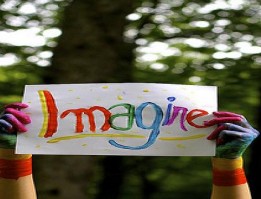Guided Visualisation in Therapy – The Benefits Might Surprise You
by Andrea M. Darcy
 Guided visualisation, also known as ‘guided image therapy’, is a psychotherapeutic tool now used for a large variety of emotional and physical conditions. It it particularly popular with cognitive behavioural therapists.
Guided visualisation, also known as ‘guided image therapy’, is a psychotherapeutic tool now used for a large variety of emotional and physical conditions. It it particularly popular with cognitive behavioural therapists.
What is guided visualisation?
Guided visualisation is a process whereby your therapist leads you through imagining in your mind’s eye a relaxing scenario. experience, or series of images. The point of guided visualisation is to harness the brain’s positive response to images to help you manage your emotions and life challenges more effectively.
Visualisation is not hypnosis, nor is it about being forced to do something or told what to do. Instead, your therapist will encourage you take a relaxed position with your eyes closed, then simply suggests parameters and encourage you to make a vivid scenario. As the client you then let the visualisation unfold in a way that works for you and your imagination. You are in control. You can even stop if you don’t feel comfortable.
 Things your therapist can guide you to visualise can include:
Things your therapist can guide you to visualise can include:
- relaxing imagined moments
- encounters with others
- scenarios you will be facing in the future
- imagining situations you already dealt with in all new ways.
They will encourage you to use all your senses when visualising. It has been found that the more detailed and real a visualisation is, the more your brain feels it is actually experiencing it and not just imagining it and the more effective the results. So visualisation can include not just what you see, but what you imagine you might smell, feel, hear, and taste, too.
Your therapist might ask you to continue working with a visualisation at home between sessions for added effectiveness.
What are the benefits of visualisation?
Guided visualisation can help you relax and let go of immediate stress. It can be quite a pleasurable experience to step outside of the present moment, and can be like a much needed mini break from reality.
It can also help you choose new outcomes for yourself and cope better with pending stressful situations. By visualising the way future events might unfold you can see new choices you might make, and new strategies that can make things go more smoothly. Or you might simply feel more prepared, which in itself helps one relax.
Visualisation can give you new perspective that releases you from being hard on yourself and can help you let go of feelings of shame or guilt or persistent negative feelings. By re-imagining past scenarios you are not happy about (called “reframing” in psychology), so that you are almost ‘watching’ yourself, you might find you have more compassion for the choices you made, even if you did lose your temper or say things you wish you didn’t. You might also have new realisations about the situation in your relaxed state that also make you feel better about what happened.
You can increase your confidence and assertiveness with guided imagery. Visualising yourself doing something well can elevate self-esteem, or using visualisation to rehearse a situation like giving a presentation can make you feel more capable.
This all adds up to elevated moods. Putting your attention on positive scenarios and imagining things going well for yourself, or realising through visualisation you’ve been hard on yourself when you didn’t need to be, can all lead to more positive thoughts and feelings.
What sort of things can guided visualisations be used for?
 Pain management – both physical and emotional pain can benefit
Pain management – both physical and emotional pain can benefit
Habit control – it can help you feel confidence in stopping behaviours like smoking or overeating
Getting motivated – imagining yourself doing something can make you feel good enough to go for it
Releasing stress – both present stress and worries about the future
Coping better – if you are nervous about a situation visualising it going well can make you feel more capable
Changing moods – it can help you change the way you feel about a situation which can shift your mood
Improving relationships – visualising new ways to act around others can change your responses and behaviours and thus your relationships
Psychological health conditions that visualisation might help with include:
- depression and anxiety
- post traumatic stress disorders
- low self-esteem
- phobias including social phobia
- behavioural disorders in children
- sexual problems
- eating disorders like anorexia and bulimia and overeating
- panic attacks
- anger management issues
- insomnia
But how can just ‘using my imagination’ make me feel better?
Emotions are powerful things. They can be like vortexes, pulling in all of our attention and causing behaviours we can’t seem to stop. The idea is that emotions are connected to our thoughts and collude to dictate our behaviours. A simple example would be the emotion of sadness, which can cause you to think negatively non stop, which can then cause you to constantly overeat or consume too much alcohol in order to escape those thoughts and feel better.
 Visualisation first of all reduces emotional arousal by relaxing you. It is hard to feel as angry or upset if your body enters a relaxed state, signalling to the brain there is less threat which then lowers your high emotional state. You then use your imagination to think of different things, which can also can create other, more positive emotions, or at least neutralise the negative ‘charge’ you were feeling.
Visualisation first of all reduces emotional arousal by relaxing you. It is hard to feel as angry or upset if your body enters a relaxed state, signalling to the brain there is less threat which then lowers your high emotional state. You then use your imagination to think of different things, which can also can create other, more positive emotions, or at least neutralise the negative ‘charge’ you were feeling.
You can see this effect for yourself immediately. Think of something that makes you upset. Then think of someone you love, or something that makes you really happy like being on a beach or playing with your pet, and try to maintain that bad feeling. You will likely find it difficult.
The science of visualisation
So how does simply imagining something actually make us feel different and behave differently?
It has been found in tests that whether we experience something or just imagine it, similar neural networks are activated.
Our sympathetic nervous system, or the ‘fight or flight’ response, is also triggered. This is why just thinking about something stressful can make our heart beat and our palms sweat.
Visualisation is simply the opposite of this – by thinking of something going well, we can elicit a positive response from our body and lower our stress.
A study at the university of Miami found that after thirteen weeks of guided imagery subjects showed a marked decrease in levels of cortisol, the ‘stress hormone’ that is linked to anxiety, fatigue and low moods.
A study at the NC Centre for Stress Management even found that using mental imagery with ill patients even resulted in an increase in white blood cells count in every single participant.
But how can imagining a stressful situation we have to experience in the future turning out well mean it might actually turn out better than we thought? While it is not completely understood, it seems that the activation of neural networks alters the way we then respond and perform in the future.
 There have been many studies carried out using visualisation on athletes that show just this result. For example, a study at the University of Western Australia had one group of basketball players practice 20 minutes a day and the other only visualise themselves making free throws but not doing any practice. The result was that those who only visualised were almost as good as the players who actually practiced.
There have been many studies carried out using visualisation on athletes that show just this result. For example, a study at the University of Western Australia had one group of basketball players practice 20 minutes a day and the other only visualise themselves making free throws but not doing any practice. The result was that those who only visualised were almost as good as the players who actually practiced.
What is the experience of guided visualisation like?
Your therapist will first encourage you to get comfortable in your chair and relax, then ask you to close your eyes. Each therapist can have their own way of doing things, and might ask you to practise some deep breathing and muscle relaxation to relax further. Some might play soft music during a visualisation.
They will then guide you slowly and calmly through a scenario. For example, if it was a visualisation for a work interview, it might involve a part like this –
“Imagine yourself at home, choosing an outfit for interviews – what do you select to represent yourself well? You are looking in the mirror at yourself, smiling and feeling assured – what are you saying to your confident self? Notice the smells and sounds of your house that make you feel safe. Let yourself really enjoy that feeling of safety. Now see yourself walking into the office your interview is at, still feeling that good, safe, confident feeling. How are you composing yourself?
You introduce yourself to the receptionist – what do you say to her? How are you holding your confidence in your body? As the receptionist guides you to the waiting room, you feel ready for this interview, prepared. What is going through your confident mind? As you meet the interviewer/s you introduce yourself with assurance – how you are confidently conducting yourself? What does that feel like?”
And at any point if you feel uncomfortable you can of course pause and speak up.
When the visualisation ends, the therapist will guide you to return your awareness to the present moment, and will allow you a moment to gently readjust and become alert again.
Guided visualisation in therapy
Visualisation is a safe and gentle technique with no reported side effects that is even used on children. If you are interested in trying it for yourself, speak to your therapist about integrating it into the work you are doing. You can also find many self-help books about guided visualisations and find free visualisations to get you started online.
Have you found guided visualisation effective for elevating your moods? Share your story below and inspire others.
Photos by Allegra Ricci, Lisa Omarali, Hartwig HKD, Andris, CapeLawOffice





I’m really glad I stumbled across this article! I feel that the word “counseling” had always kind of held a negative connotation and that normal people don’t just sit in a room with someone and talk about their problems. After doing a fair amount of research though I’ve found that there are tons of benefits of talking with a professional to become more self aware. I am definitely considering going through a self awareness process where counseling plays a big part.
Great article. Thanks for sharing this.
Glad you enjoyed it!